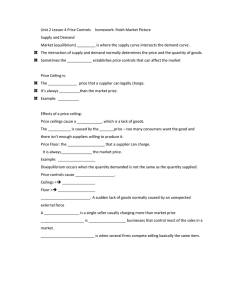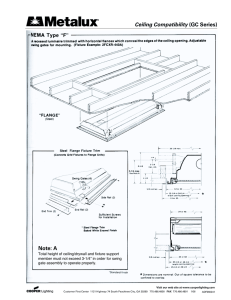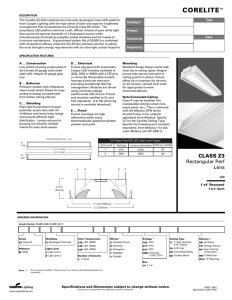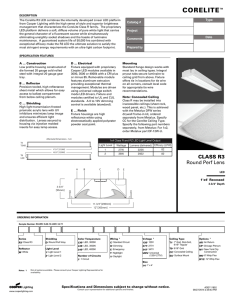all about plenum ceilings
advertisement
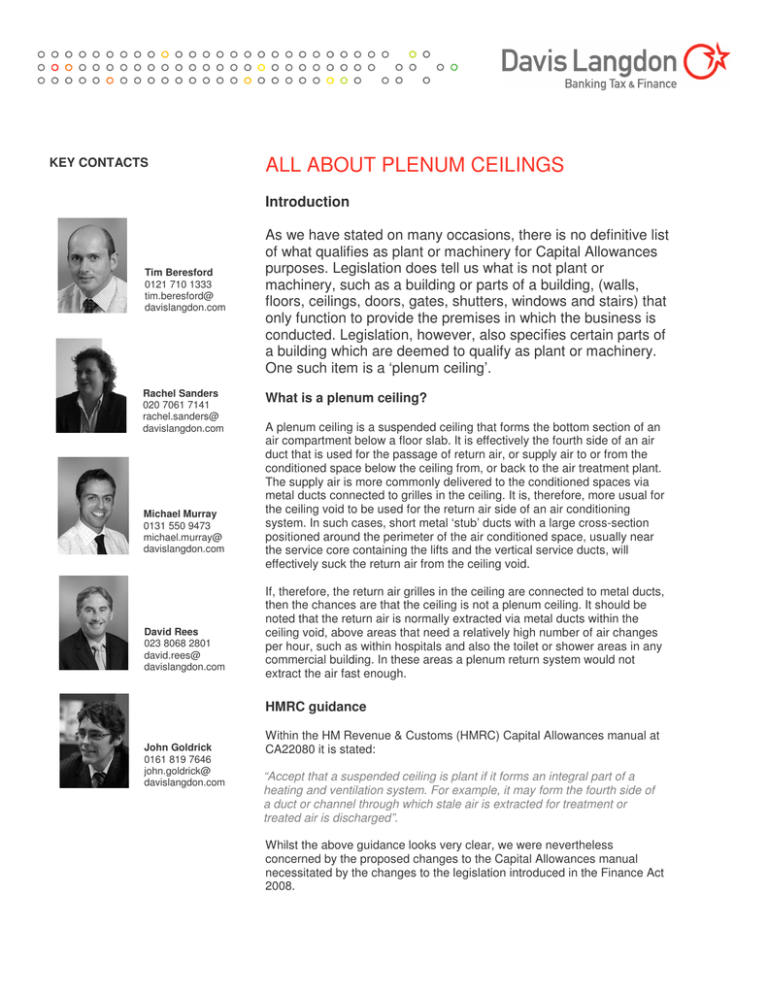
KEY CONTACTS ALL ABOUT PLENUM CEILINGS Introduction Tim Beresford 0121 710 1333 tim.beresford@ davislangdon.com Rachel Sanders 020 7061 7141 rachel.sanders@ davislangdon.com Michael Murray 0131 550 9473 michael.murray@ davislangdon.com David Rees 023 8068 2801 david.rees@ davislangdon.com As we have stated on many occasions, there is no definitive list of what qualifies as plant or machinery for Capital Allowances purposes. Legislation does tell us what is not plant or machinery, such as a building or parts of a building, (walls, floors, ceilings, doors, gates, shutters, windows and stairs) that only function to provide the premises in which the business is conducted. Legislation, however, also specifies certain parts of a building which are deemed to qualify as plant or machinery. One such item is a ‘plenum ceiling’. What is a plenum ceiling? A plenum ceiling is a suspended ceiling that forms the bottom section of an air compartment below a floor slab. It is effectively the fourth side of an air duct that is used for the passage of return air, or supply air to or from the conditioned space below the ceiling from, or back to the air treatment plant. The supply air is more commonly delivered to the conditioned spaces via metal ducts connected to grilles in the ceiling. It is, therefore, more usual for the ceiling void to be used for the return air side of an air conditioning system. In such cases, short metal ‘stub’ ducts with a large cross-section positioned around the perimeter of the air conditioned space, usually near the service core containing the lifts and the vertical service ducts, will effectively suck the return air from the ceiling void. If, therefore, the return air grilles in the ceiling are connected to metal ducts, then the chances are that the ceiling is not a plenum ceiling. It should be noted that the return air is normally extracted via metal ducts within the ceiling void, above areas that need a relatively high number of air changes per hour, such as within hospitals and also the toilet or shower areas in any commercial building. In these areas a plenum return system would not extract the air fast enough. HMRC guidance John Goldrick 0161 819 7646 john.goldrick@ davislangdon.com Within the HM Revenue & Customs (HMRC) Capital Allowances manual at CA22080 it is stated: “Accept that a suspended ceiling is plant if it forms an integral part of a heating and ventilation system. For example, it may form the fourth side of a duct or channel through which stale air is extracted for treatment or treated air is discharged”. Whilst the above guidance looks very clear, we were nevertheless concerned by the proposed changes to the Capital Allowances manual necessitated by the changes to the legislation introduced in the Finance Act 2008. Plenum ceilings - 2 The following text was proposed by HMRC at CA22320 within the revised guidance issued with Revenue & Customs Brief 66/08 in December 2008: “The rules also specifically clarify that the new definition does not extend to any asset whose principal purpose is to insulate or enclose the interior of a building, or to provide interior walls, floors or ceilings which are intended to remain permanently in place. So if a person installs a new ceiling as part of a new air conditioning system, the ceiling is not an integral feature if it is intended to remain permanently in place”. The above guidance would have made it very difficult to decide when a plenum ceiling qualified for Capital Allowances and when it did not. Certainly the more inflexible plaster board ceilings described above would probably have been excluded on the basis that they were designed to be permanent. Even in the case of proprietary systems, there would almost certainly have been some doubt in each case as to whether or not the ceilings were plant. To the credit of HMRC, the proposed changes to the Capital Allowances manual were drafted for consultation. Responses were requested by HMRC by 10 February 2009. Within our response we pointed out the confusion that would arise if the proposed text at CA22320 was adopted. No doubt we were not alone in our assertions because HMRC reconsidered the issue and subsequently issued the following guidance at CA22320 in August 2009: “The rules also specifically clarify that the new definition does not extend to any asset whose principal purpose is to insulate or enclose the interior of a building, or to provide interior walls, floors or ceilings which are intended to remain permanently in place (S23(4) and S33A(6)). So if, for example, a business installs a new, permanent false ceiling in its premises, in order to conceal new wiring and service pipes, expenditure on that ceiling would not qualify for plant and machinery allowances. On the other hand, if a business installs in its premises a plenum floor or plenum ceiling, the principal purpose of which is to function as an integral part of the heating or air conditioning system (for example, the plenum floor or plenum ceiling may form the fourth side of a duct or channel through which stale air is extracted and treated air is discharged), that expenditure would qualify for plant and machinery allowances as part of an ‘integral feature’ of the building or structure”. The revise guidance set out above should result in far more clarity than would have been the case with the initial proposals. It is difficult to interpret the revised guidance in any other way than to conclude that all types of plenum ceilings will qualify as integral features for Capital Allowances. Summary Most modern commercial buildings contain suspended ceilings. In a large open plan office tower the cost of the suspended ceilings will easily run into several hundred thousand pounds and could even reach a seven figure sum. It should, therefore, be very important to property owners and occupiers, whether or not the costs of their ceilings are eligible for tax relief. In the case of a purchased property, there is also the issue of establishing the expenditure incurred on the ceilings. This is, therefore, certainly an area where the Capital Allowances specialist can add value. For further advice concerning any of the issues raised in this briefing, please contact one of our key individuals detailed overpage, or alternatively call our helpline on 0800 526262. Information on other property tax related topics can also be found on our website at http://bankingtaxfinance.davislangdon.com. Cost Management | Project Management | Program Management | Banking Tax & Finance | Building Surveying | Design Management | Engineering Services | Health & Safety Services | Legal Support | Management Consulting | Mixed-use Masterplanning | People, Place, Performance Consulting | Specification Consulting http://bankingtaxfinance.davislangdon.com Whilst every effort has been made to ensure accuracy at time of publication, dated September 2010, information contained in this document may not be comprehensive or reflect individual circumstances or may be subject to subsequent revision and legislative changes. Recipients should therefore not act on any information without seeking professional advice.

